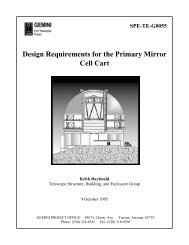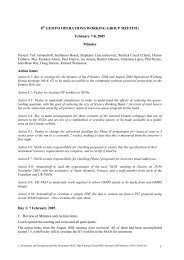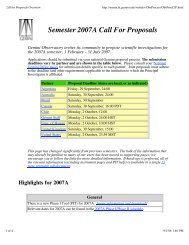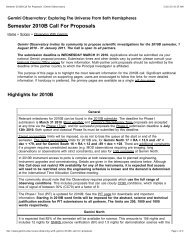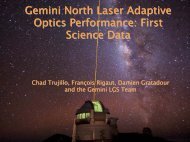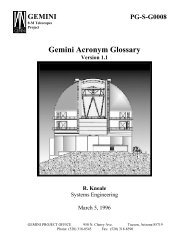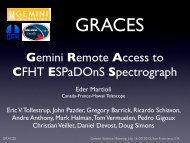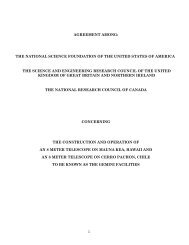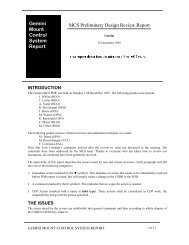spe-o-g0039 m2 tilt system design requirements document
spe-o-g0039 m2 tilt system design requirements document
spe-o-g0039 m2 tilt system design requirements document
You also want an ePaper? Increase the reach of your titles
YUMPU automatically turns print PDFs into web optimized ePapers that Google loves.
SPE-O-G0039<br />
M2 TILT SYSTEM<br />
DESIGN REQUIREMENTS DOCUMENT
SPE-O-G0039<br />
revision B<br />
revision description date approved<br />
NC Initial Release 3/8/95 J. L. Roberts<br />
A Incorporated Amendment 3<br />
Incorporated Amendment 4<br />
12/21/95 J. L. Roberts<br />
B Incorporated Amendment 6 4/23/96 J. L. Roberts
1.0 SCOPE This <strong>document</strong> details the <strong>requirements</strong> of the two axis <strong>tilt</strong> and axial translation M2<br />
Tilt System for the f/16 infrared (IR) secondary mirror assembly of the Gemini eight meter<br />
telescopes. The M2 Tilt System consists of the M2 Tilt Mechanism, the M2 Tilt Sensor<br />
Electronics Module, the M2 Tilt Control Electronics Module, a fiber optic link with interface<br />
to the Secondary Control System, and associated cabling. The M2 Tilt Mechanism supports<br />
the f/16 IR Secondary Mirror.<br />
The M2 Tilt System shall provide for pointing oscillation between field angles for the<br />
telescope when operated in the Chopping mode for cancellation of sky and telescope<br />
background radiation. It will also provide <strong>tilt</strong> for fast guiding and wavefront <strong>tilt</strong> correction.<br />
The M2 Tilt System shall have a slow <strong>tilt</strong> capability over a range greater than that used for<br />
Chopping or fast guiding/wave front <strong>tilt</strong> correction. The M2 Tilt System shall provide axial<br />
translation in both a fast and a slow mode. The M2 Tilt System shall do so without causing<br />
excessive image distortion.<br />
The M2 Tilt System shall provide communication with the Secondary Control System<br />
and the M2 Positioning System. The M2 Tilt System shall provide control functions for the<br />
M2 Positioning System, the M2 Deployable Baffle and the M2 Central Baffle. The M2 Tilt<br />
Control Electronics shall provide motor control signals to the M2 Positioning Drive Amplifier<br />
Module where the power amplifiers/motor drivers for the M2 Positioning System, the M2<br />
Deployable Baffle and the M2 Central Baffle are located. The M2 Tilt Control Electronics<br />
Module does not drive the motors for the M2 Positioning System, the M2 Deployable Baffle<br />
and the M2 Central Baffle directly.<br />
Except as otherwise provided herein, Contractor shall be solely responsible for<br />
insuring that the M2 Tilt Systems comply with all <strong>requirements</strong> set forth in the Design<br />
Requirements Document.<br />
1.1 PARAGRAPH REFERENCES When a paragraph within this Design Requirements<br />
Document is referenced each applicable subindentured paragraph shall be considered as<br />
referenced also .<br />
1.2 DEFINITIONS The following terms are defined and their use throughout this Design<br />
Requirements Document will be consistent with these definitions.<br />
(a) Actuator - An "Actuator" is a device used to produce motion of the f/16 Secondary Mirror.<br />
Each f/16 Secondary Mirror Mounting Feature shall have Actuators to produce motion in<br />
fast and slow modes. Actuators used for slow articulation need not be the same as those<br />
used for articulation in the fast modes of operation.<br />
(b) c.g. - The term "c.g." means center of gravity.<br />
SPE-O-G0039<br />
revision B<br />
(c) Chopping - "Chopping" is the act of moving the f/16 Secondary Mirror in <strong>tilt</strong> between field<br />
positions in a regular, repeated manner.<br />
page 1
(d) Damper - A "Damper" is a device acting on an Actuator that prevents motion of the<br />
associated f/16 Secondary Mirror Mounting Feature.<br />
(e) decenter - "Decenter" is motion of the f/16 Secondary Mirror Position in any direction<br />
perpendicular to the Z axis defined in section 3.1.1.4 below.<br />
(f) Dummy Mirror - The "Dummy Mirror" is a device used to simulate the f/16 Secondary<br />
Mirror for testing without the f/16 Secondary Mirror. Its properties are described in section<br />
4.2.1 below.<br />
(g) Encoder - An "Encoder" translates the output of a Sensor into a form that may be used by<br />
the Secondary Control System.<br />
(h) f/16 Secondary Assembly - The "f/16 Secondary Assembly" consists of the f/16 Secondary<br />
Mirror, the M2 Tilt System, the M2 Positioning System, the M2 Deployable Baffle, the M2<br />
Central Baffle, and their associated electronics, cabling and mounting hardware.<br />
(i) f/16 Secondary Mirror - The "f/16 Secondary Mirror" is defined as the M2 mirror blank,<br />
drawing 85-GP-3200-0004, with the bracket, drawing 85-GP-3100-0003, and the flexure,<br />
drawing 85-GP-3100-0002, installed in accordance with drawing 90-GP-0003-0001.<br />
(j) f/16 Secondary Mirror Mounting Features - The "f/16 Secondary Mirror Mounting<br />
Features" are shown on drawing 85-GP-3100-0004. They are the mechanical interface<br />
between the f/16 Secondary Mirror and the M2 Tilt Mechanism.<br />
(k) f/16 Secondary Mirror Mounting Hardware - The "f/16 Secondary Mirror Mounting<br />
Hardware" consists of the parts <strong>spe</strong>cified on drawing 90-GP-0003-0001 to mount the f/16<br />
Secondary Mirror to the M2 Tilt Mechanism.<br />
(l) f/16 Secondary Mirror Position - The "f/16 Secondary Mirror Position" is the combination<br />
of the location of the f/16 Secondary Mirror c.g. and <strong>tilt</strong> of the f/16 Secondary Mirror about<br />
its c.g. relative to the M2 Tilt Mechanism Mounting Features.<br />
(m) focus - "Focus" is linear motion of the f/16 Secondary Mirror c.g. in the Z direction.<br />
There is no <strong>tilt</strong> of the f/16 Secondary Mirror associated with focus motion.<br />
(n) horizon pointing - "Horizon pointing" is defined as the mechanical axes, as defined on<br />
drawing 85-GP-3100-0004, oriented with the X and Z axes in the horizontal direction and<br />
the Y axis oriented vertically up.<br />
(o) i/o - "i/o" is the abbreviation for "input/output".<br />
(p) i/p - "i/p" is the abbreviation for "input".<br />
SPE-O-G0039<br />
revision B<br />
page 2
SPE-O-G0039<br />
revision B<br />
(q) Lifting Points - The "Lifting Points" are shown and identified on drawing<br />
85-GP-3100-0004.<br />
(r) M2 Central Baffle - The "M2 Central Baffle" is a baffle in the center of the Secondary<br />
Support Structure of the Telescope. It is deployed to one of two positions.<br />
(s) M2 Deployable Baffle - The "M2 Deployable Baffle" is a subassembly of the f/16<br />
Secondary Assembly. The "M2 Deployable Baffle" contains leaves that are extended or<br />
retracted to one of four positions.<br />
(t) M2 Positioning Control Algorithm - The "M2 Positioning Control Algorithm" is the<br />
software process used to:<br />
a) receive position commands for the M2 Positioning Mechanism, the M2 Deployable<br />
Baffle and the M2 Central Baffle from the Secondary Control System,<br />
b) calculate the current position of the M2 Positioning Mechanism, the M2 Deployable<br />
Baffle and the M2 Central Baffle based on sensor inputs from the M2 Positioning<br />
System,<br />
c) calculate the required motions of the motors contained in the M2 Positioning<br />
Mechanism, the M2 Deployable Baffle and the M2 Central Baffle to achieve the<br />
commanded position of the M2 Positioning Mechanism, the M2 Deployable Baffle and<br />
the M2 Central Baffle, and<br />
d) to send motor commands for the M2 Positioning Mechanism, the M2 Deployable Baffle<br />
and the M2 Central Baffle to the M2 Positioning Drive Amplifier Module.<br />
(u) M2 Positioning Drive Amplifier Module - The "M2 Positioning Drive Amplifier Module"<br />
contains the drive amplifiers for the motors of the M2 Positioning System, the M2<br />
Deployable Baffle and the M2 Central Baffle."<br />
(v) M2 Positioning System - The "M2 Positioning System" is the <strong>system</strong> used to provide<br />
translation of the M2 Tilt Mechanism and the f/16 Secondary Mirror in the plane parallel to<br />
the X and Y axes.<br />
(w) M2 Tilt Control Electronics Module - The "M2 Tilt Control Electronics Module" is a<br />
single enclosure containing the electronics that are not necessary to be in close proximity to<br />
the M2 Tilt Mechanism. Its size, location, mounting details and interfaces are <strong>spe</strong>cified on<br />
drawing 85-GP-3100-0004.<br />
(x) M2 Tilt Mechanism - The "M2 Tilt Mechanism" contains the Actuators and Sensors used<br />
to produce the required motion of the f/16 Secondary Mirror. It is contained in the<br />
envelope <strong>spe</strong>cified by drawing 85-GP-3100-0004. The f/16 Secondary Mirror is attached<br />
to the M2 Tilt Mechanism with the parts and in the manner <strong>spe</strong>cified on drawing<br />
90-GP-0003-0001. The M2 Tilt Mechanism is mounted in the manner <strong>spe</strong>cified in section<br />
4.1 below.<br />
page 3
(y) M2 Tilt Sensor Electronics Module - The "M2 Tilt Sensor Electronics Module" contains<br />
the electronics that must be located in close proximity to the M2 Tilt Mechanism in order<br />
for the M2 Tilt System to meet its <strong>requirements</strong>. Its size, location, mounting details and<br />
interfaces are <strong>spe</strong>cified on drawing 85-GP-3100-0004.<br />
(z) M2 Tilt System - The "M2 Tilt System" is the <strong>system</strong> used to <strong>tilt</strong> and focus the f/16<br />
Secondary Mirror. The "M2 Tilt System" also provides motor control signals to the M2<br />
Positioning Drive Amplifier Module where the power amplifiers/motor drivers for the M2<br />
Positioning System, the M2 Deployable Baffle and the M2 Central Baffle are located. The<br />
M2 Tilt Control Electronics Module does not drive the motors for the M2 Positioning<br />
System, the M2 Deployable Baffle and the M2 Central Baffle directly. The M2 Tilt<br />
System contains the M2 Tilt Mechanism, the M2 Tilt Sensor Electronics Module, M2 Tilt<br />
Control Electronics Module, a fiber optic link with interface to the Secondary Control<br />
System, and their associated cabling. The M2 Tilt System envelope is <strong>spe</strong>cified on<br />
drawing 85-GP-3100-0004.<br />
(aa) non-repeatability Use of the term "non-repeatability" in this <strong>document</strong> is defined as the<br />
subject event being between 3 standard deviations, six (6) standard deviations total, of a<br />
Gaussian frequency distribution. The value stated is the full six (6) standard deviation<br />
range.<br />
(ab) o/p - "o/p" is the abbreviation for "output".<br />
(ac) Safety Stop Mounting Points - The "Safety Stop Mounting Points" are the three tapped<br />
holes shown and identified on drawing 85-GP-3100-0004.<br />
(ad) Secondary Control System - The "Secondary Control System" is the portion of the<br />
Telescope Control System that the M2 Tilt System must interface with electronically.<br />
(ae) Secondary Support Structure - The "Secondary Support Structure" is that part of the<br />
Telescope the f/16 Secondary Assembly is mounted to.<br />
(af) Sensors - The "Sensors", which are contained in the M2 Tilt Mechanism, measure the<br />
position of each of the f/16 Secondary Mirror Mounting Features.<br />
(ag) Set Position - The "Set Position" is the f/16 Secondary Mirror Position in <strong>tilt</strong> and focus<br />
set by the slow modes of operation. Fast <strong>tilt</strong>, focus and Chopping occur about and are<br />
relative to the Set Position.<br />
(ah) Telescope - The "Telescope" is the Gemini 8 meter telescope.<br />
SPE-O-G0039<br />
revision B<br />
(ai) Telescope Control System - The "Telescope Control System" is the electronic control<br />
<strong>system</strong> for the Telescope.<br />
page 4
(aj) zenith pointing - "Zenith pointing" is defined as the mechanical axes, as defined on<br />
drawing 85-GP-3100-0004, oriented with the X and Y axes in the horizontal direction and<br />
the Z axis oriented vertically up.<br />
2.0 APPLICABLE DOCUMENTS The following <strong>document</strong>s form a part of this Design<br />
Requirements Document to the extent referenced.<br />
2.1 U. S. Government Documents<br />
2.1.1 Military Standards<br />
MIL-STD-810E, July 1989<br />
2.2 AURA Project Documents.<br />
2.2.1 Drawings<br />
85-GP-3100-0004 ENVELOPE, TIP-TILT SYSTEM, f/16 SECONDARY MIRROR<br />
85-GP-3200-0004 SMALL SECONDARY MIRROR ASSEMBLY<br />
85-GP-3200-0002 FLEXURE, MIRROR MOUNTING<br />
85-GP-3200-0003 BRACKET, MIRROR MOUNTING<br />
85-GP-3200-0001 STUD, MIRROR MOUNTING<br />
90-GP-0003-0001 ICD, MIRROR TO TIP-TILT SYSTEM<br />
2.2.2 Requirements Documents<br />
SPE-ASA-G0008 GEMINI ELECTRONIC DESIGN SPECIFICATION<br />
3.0 REQUIREMENTS Unless otherwise <strong>spe</strong>cified, the M2 Tilt System shall meet all of the<br />
<strong>requirements</strong> of this Design Requirements Document with the f/16 Secondary Mirror installed<br />
in accordance with drawing 90-GP-0003-0001 and with the M2 Tilt System mounted on<br />
datum -C-, shown on drawing 85-GP-3100-0004, with six M24 2.0 bolts torqued to 950 N-m.<br />
3.1 Mechanical Requirements<br />
SPE-O-G0039<br />
revision B<br />
3.1.1 Physical Requirements The M2 Tilt System shall conform to the envelope defined by<br />
drawing 85-GP-3100-0004.<br />
3.1.1.1 The M2 Tilt Mechanism shall have a mass no greater than 100 kg. The M2 Tilt Sensor<br />
Electronics Module shall have a mass no greater than 30 kg.<br />
3.1.1.2 The M2 Tilt Mechanism shall mount on datum -C-, as shown on drawing<br />
85-GP-3100-0004.<br />
3.1.1.3 The f/16 Secondary Mirror shall be mounted with the f/16 Secondary Mirror Mounting<br />
Hardware, and as shown in drawing 90-GP-0003-0001.<br />
page 5
SPE-O-G0039<br />
revision B<br />
3.1.1.3.1 Forces exerted on the f/16 Secondary Mirror to produce articulation in accordance with<br />
any provision of this Design Requirements Document or during application of the Dampers<br />
shall not exceed 300 N at any Actuator in any direction.<br />
3.1.1.3.2 The M2 Tilt Mechanism shall not exert forces on the f/16 Secondary Mirror due to<br />
articulation in accordance with any portion of this Design Requirements Document in the X-Y<br />
plane of the f/16 Secondary Mirror in excess of .55 N over the range of motion <strong>spe</strong>cified in<br />
section 3.1.2 below, over the temperature range <strong>spe</strong>cified in section 3.4.1 below and with<br />
gravity oriented over the range <strong>spe</strong>cified in section 3.4.1 below.<br />
3.1.1.3.3 No force at any point of attachment of the f/16 Secondary Mirror shall be exerted on<br />
the f/16 Secondary Mirror in the X-Y plane, to support the f/16 Secondary Mirror, greater than<br />
60% of the f/16 Secondary Mirror’s weight over the range of motion <strong>spe</strong>cified in section 3.1.2<br />
below, over the temperature range <strong>spe</strong>cified in section 3.4.1 below and with gravity oriented<br />
over the range <strong>spe</strong>cified in section 3.4.5 below.<br />
3.1.1.3.4 No force at any point of attachment of the f/16 Secondary Mirror shall be exerted on<br />
the f/16 Secondary Mirror in the X-Y plane by any Damper greater than 60% of the f/16<br />
Secondary Mirror’s weight over the range of motion <strong>spe</strong>cified in section 3.1.2 below, over the<br />
temperature range <strong>spe</strong>cified in section 3.4.3 below and with gravity oriented over the range<br />
<strong>spe</strong>cified in section 3.4.2 below.<br />
3.1.1.4 The coordinate <strong>system</strong> for the M2 Tilt Mechanism is shown on drawing<br />
85-GP-3100-0004. The axes are located and oriented from the datums as shown on drawing<br />
85-GP-3100-0004. The X axis is oriented horizontally for all operations.<br />
3.1.1.5 The M2 Tilt Mechanism shall not be adversely affected by materials and procedures used<br />
in cleaning the f/16 Secondary Mirror optical surface. Materials used in cleaning the f/16<br />
Secondary Mirror optical surface include CO 2<br />
snow, alcohol, acetone, detergent/water<br />
solutions and de-ionized water. The f/16 Secondary Mirror optical surface will be cleaned in<br />
the horizon pointing orientation.<br />
3.1.1.6 The f/16 Secondary Mirror Mounting Features shall withstand the torque used to mount<br />
the f/16 Secondary Mirror in accordance with drawing 90-GP-0003-0001.<br />
3.1.1.7 The M2 Tilt Mechanism shall have three Lifting Points. They shall be located as shown<br />
on drawing 85-GP-3100-0004. Each Lifting Point shall be capable of supporting the M2 Tilt<br />
Mechanism weight with the f/16 Secondary Mirror and f/16 Secondary Mirror Mounting<br />
Hardware installed in accordance with drawing 90-GP-0003-0001.<br />
3.1.1.8 The M2 Tilt Mechanism shall have three Safety Stop Mounting Points to which the<br />
Safety Stops (item 7 on drawing 90-GP-0003-0001) can be installed as shown in drawing<br />
90-GP-0003-0001. Such Safety Stop Mounting Points shall be located as shown on drawing<br />
85-GP-3100-0004. Such Safety Stop Mounting Points shall be capable of supporting the full<br />
mass of the f/16 Secondary Mirror when the fully assembled M2 Tilt Mechanism, Safety<br />
page 6
SPE-O-G0039<br />
revision B<br />
Stops, and the f/16 Secondary Mirror are subjected to the environmental conditions described<br />
in Section 3.4.3, below, including all forces on such components arising during such<br />
conditions. The Safety Stop Mounting Points shall also be capable of holding the Safety<br />
Stops when the fully assembled M2 Tilt Mechanism, Safety Stops, and the f/16 Secondary<br />
Mirror are subjected to the forces that would be generated by any failure of the f/16 Secondary<br />
Mirror Mounting Hardware or by any failure of the M2 Tilt Mechanism.<br />
3.1.1.9 The M2 Tilt Mechanism shall include a removable cover. The cover shall be the exterior<br />
surface of the M2 Tilt Mechanism with the exception that the cover shall not obstruct access<br />
to the f/16 Secondary Mirror Mounting Features, the safety stop features, the lifting points, the<br />
central hole through the M2 Tilt Mechanism or datum -C- on drawing 85-GP-3100-0004. The<br />
cover shall not exceed the maximum envelope <strong>spe</strong>cified on drawing 85-GP-3100-0004. The<br />
cover shall limit heat transfer from the M2 Tilt System to the f/16 Secondary Mirror by<br />
radiation and from the M2 Tilt System in the X and Y direction by radiation.<br />
3.1.2 Range of Motion The f/16 Secondary Mirror Mounting Features shall translate in the Z<br />
direction to produce focus and <strong>tilt</strong> motion of the f/16 Secondary Mirror. The total translation<br />
of the f/16 Secondary Mirror Mounting Features is shown on drawing 85-GP-3100-0004 and<br />
is the sum of that necessary for <strong>tilt</strong> and focus. The M2 Tilt System shall be capable of<br />
producing motion of the f/16 Secondary Mirror in any combination of the following motions<br />
<strong>spe</strong>cified in sections 3.1.2.1 and 3.1.2.2 below. The combination of fast and slow modes<br />
operation shall not cause the f/16 Secondary Mirror Position to exceed the envelope of motion<br />
shown in figure 1.<br />
3.1.2.1 The M2 Tilt System shall be capable of producing the range of f/16 Secondary Mirror<br />
Position in focus and <strong>tilt</strong> shown in figure 1 when operated in the slow modes <strong>spe</strong>cified in<br />
section 3.3.1 below.<br />
Figure 1: Range of f/16 Secondary Mirror Position<br />
page 7
3.1.2.2 The M2 Tilt System shall be capable of producing translation of the f/16 Secondary<br />
Mirror c.g. in the fast modes of operation <strong>spe</strong>cified in section 3.3.2 below in the Z direction of<br />
25 m total. The M2 Tilt System shall be capable of producing f/16 Secondary Mirror <strong>tilt</strong>s in<br />
the fast modes of operation <strong>spe</strong>cified in section 3.3.2 below up to 2.2 arcminutes total.<br />
3.1.2.3 The M2 Tilt Mechanism shall contain mechanical stops to limit motion in the Z direction<br />
of each f/16 Secondary Mirror Mounting Feature. The mechanical stops shall be set to<br />
prevent any portion of the f/16 Secondary Mirror Mounting Hardware from coming into<br />
contact with any other portion of the f/16 Secondary Mirror Mounting Hardware. The<br />
mechanical stops shall be adequately cushioned to prevent excessive shock being transmitted<br />
to the f/16 Secondary Mirror Mounting Features.<br />
3.1.3 Mechanical Accuracies<br />
SPE-O-G0039<br />
revision B<br />
3.1.3.1 During operation of the M2 Tilt System in Chopping in accordance with section 3.3.2.1<br />
below, the M2 Tilt System shall meet the following <strong>requirements</strong> during the viewing cycle<br />
times shown in figures 2, 4 and 6:<br />
3.1.3.1.1 The mechanical inaccuracy of the f/16 Secondary Mirror Position, in <strong>tilt</strong>, shall be no<br />
greater than 0.100 arcsecond total including, without limitation, oscillation, non-repeatability<br />
and settling band. The M2 Tilt System shall meet these <strong>requirements</strong> over any 1 minute<br />
period.<br />
3.1.3.1.2 The variation of f/16 Secondary Mirror Position, in decenter, shall be no greater than<br />
2.000 m total including, without limitation, oscillation and non-repeatability. The M2 Tilt<br />
System shall meet these <strong>requirements</strong> over any 1 minute period.<br />
3.1.3.1.3 The variation of the f/16 Secondary Mirror Position in the Z direction, relative to the<br />
Set Position, shall be no greater than 10.000 m total including, without limitation, oscillation<br />
and non-repeatability. The M2 Tilt System shall meet these <strong>requirements</strong> over any 1 minute<br />
period.<br />
3.1.3.2 During operation of the M2 Tilt System in any combination of the modes contained in<br />
sections 3.3.1, 3.3.2.2 and 3.3.2.3 below, the M2 Tilt System shall meet the following<br />
<strong>requirements</strong>:<br />
3.1.3.2.1 The deviation of the f/16 Secondary Mirror Position, in <strong>tilt</strong>, from the position<br />
commanded during the applicable operations, shall be no greater than 0.025 arcsecond total.<br />
The M2 Tilt System shall meet these <strong>requirements</strong> over any 1 minute period.<br />
3.1.3.2.2 The variation of the f/16 Secondary Mirror Position, in decenter, shall be no greater<br />
than 0.300 m total including, without limitation, oscillation and non-repeatability. The M2<br />
Tilt System shall meet these <strong>requirements</strong> over any 1 minute period.<br />
page 8
SPE-O-G0039<br />
revision B<br />
3.1.3.2.3 The mechanical inaccuracy of the f/16 Secondary Mirror Position, in the Z direction,<br />
shall be no greater than 2.000 m total incuding, without limitation, deviation from the f/16<br />
Secondary Mirror Position commanded during the applicable operations. The M2 Tilt System<br />
shall meet these <strong>requirements</strong> over any 1 minute period.<br />
3.1.3.3 With the f/16 Secondary Mirror installed in accordance with drawing 90-GP-0003-0001,<br />
the motion of the f/16 Secondary Mirror Position shall not decenter from the mechanical axes<br />
defined in section 3.1.1.4 above by more than 200 m total over the full range of travel in the<br />
Z direction in accordance with section 3.1.2 above and the operating and performance<br />
environments of section 3.4 below. Over the same range of travel and environments, the<br />
non-repeatability of f/16 Secondary Mirror Position in the X-Y plane shall not exceed 5 m<br />
total.<br />
3.1.3.4 The reaction force and moment exerted by the M2 Tilt Mechanism on its supporting<br />
structure must be limited to avoid exciting telescope resonances. In particular, the amplitudes<br />
of the individual peaks in the reaction frequency <strong>spe</strong>ctra shall be below the levels <strong>spe</strong>cified in<br />
this section 3.1.3.4. Wind loading shall not be included in this requirement.<br />
3.1.3.4.1 During operation of the M2 Tilt System in Chopping in accordance with section 3.3.2.1<br />
below, the M2 Tilt Mechanism reaction forces and moments shall meet the following<br />
<strong>requirements</strong>:<br />
3.1.3.4.1.1 No peak in the frequency <strong>spe</strong>ctrum of the reaction moment exerted by the M2 Tilt<br />
Mechanism on its supporting structure shall be greater than 0.5 N-m peak;<br />
3.1.3.4.1.2 No peak in the frequency <strong>spe</strong>ctrum of the reaction force in the Z direction exerted by<br />
the M2 Tilt Mechanism on its supporting structure shall be greater than 1.5 N peak; and<br />
3.1.3.4.1.3 No peak in the frequency <strong>spe</strong>ctrum of the reaction force in the X-Y plane exerted by<br />
the M2 Tilt Mechanism on its supporting structure shall be greater than 0.10 N peak.<br />
3.1.3.4.2 During operation of the M2 Tilt System in any combination of the modes contained in<br />
sections 3.3.1, 3.3.2.2 and 3.3.2.3 below, the M2 Tilt Mechanism reaction forces and<br />
moments shall meet the following <strong>requirements</strong>:<br />
3.1.3.4.2.1 No peak in the frequency <strong>spe</strong>ctrum of the reaction moment exerted by the M2 Tilt<br />
Mechanism on its supporting structure shall be greater than 0.1 N-m peak;<br />
3.1.3.4.2.2 No peak in the frequency <strong>spe</strong>ctrum of the reaction force in the Z direction exerted by<br />
the M2 Tilt Mechanism on its supporting structure shall be greater than 0.3 N peak; and<br />
3.1.3.4.2.3 No peak in the frequency <strong>spe</strong>ctrum of the reaction force in the X-Y plane exerted by<br />
the M2 Tilt Mechanism on its supporting structure shall be greater than 0.10 N peak.<br />
page 9
3.1.4 Deflection Under Load Deflections shall be measured relative to the M2 Tilt Mechanism<br />
mounting surface shown on drawing 85-GP-3100-0004. Deflections shall be measured with<br />
the M2 Tilt Mechanism mounted by the mounting features shown in drawing<br />
85-GP-3100-0004. Deflections shall be measured with the f/16 Secondary Mirror mounted in<br />
accordance with drawing 90-GP-0003-0001. Deflections may be measured with the control<br />
electronics operating.<br />
3.1.4.1 The f/16 Secondary Mirror shall not decenter more than 20 m in the X-Y plane,<br />
translate in the Z direction more than 3 m, nor <strong>tilt</strong> more than 3 arcseconds between horizon<br />
pointing and zenith pointing orientations.<br />
3.1.5 Natural Frequencies With the M2 Tilt Mechanism mounted on its mounting features and<br />
with the f/16 Secondary Mirror mounted in accordance with drawing 90-GP-0003-0001, the<br />
minimum natural frequency shall be no less than 120 Hz. The M2 Tilt System is allowed to<br />
meet this requirement with the electronics operating. This requirement does not apply to M2<br />
Tilt System control bandwidth.<br />
3.2 Electrical Requirements The electrical components shall be located in three (3) modules.<br />
The M2 Tilt Mechanism shall contain only those components that must be incorporated in the<br />
M2 Tilt Mechanism for its operation. The M2 Tilt Sensor Electronics Module shall contain<br />
only those components that must be located in close proximity to the M2 Tilt Mechanism to<br />
assure meeting the <strong>requirements</strong> of this Design Requirements Document. All other<br />
components shall be located in the M2 Tilt Control Electronics Module.<br />
3.2.1 Actuators<br />
SPE-O-G0039<br />
revision B<br />
3.2.1.1 The Actuators producing articulation of the f/16 Secondary Mirror shall be electrically<br />
operated.<br />
3.2.1.2 Articulation in any of the fast modes of operation in accordance with any requirement of<br />
this Design Requirements Document shall use no more than one half of each Actuator's rated<br />
force capacity.<br />
3.2.2 Encoders Each Actuator shall have Encoders to encode the position of each f/16<br />
Secondary Mirror Mounting Feature in the Z direction. The Encoder signals shall be available<br />
to the Secondary Control System in accordance with section 3.2.6 below.<br />
3.2.2.1 Non-repeatability of the calibrated Encoder output shall be no greater than 0.020 m<br />
total over the full range of travel.<br />
3.2.2.2 Non-linearity of the calibrated Encoder output shall not exceed 0.5 m total over the full<br />
range of travel.<br />
3.2.2.3 Provision shall be made to adjust mechanical null of the Encoders over a range of 0.005<br />
m total.<br />
page 10
SPE-O-G0039<br />
revision B<br />
3.2.2.4 Provision shall be made to allow adjustment of electrical null of the Encoders over a<br />
range of 0.001 m total.<br />
3.2.3 Power Consumption The M2 Tilt System shall meet the <strong>requirements</strong> set forth in this<br />
section 3.2.3. No active cooling will be available to the M2 Tilt Mechanism nor to the M2<br />
Tilt Sensor Electronics Module. Coolant will be available to the M2 Tilt Control Electronics<br />
Module at a flow rate up to 2 liter/minute, at ambient temperature, with an inlet gauge<br />
pressure of TBD. Coolant will be a mixture of water and ethylene glycol.<br />
3.2.3.1 When operated in the Chopping mode, the total power input to the M2 Tilt Mechanism<br />
shall not exceed 75 watts rms over any 1 minute period. When operated in any combination<br />
modes other than Chopping contained in this Design Requirements Document, the total power<br />
input to the M2 Tilt Mechanism shall not exceed 12 watts rms over any 1 minute period.<br />
These <strong>requirements</strong> shall be met with all sub<strong>system</strong>s of the M2 Tilt System energized and<br />
signals applied to the relevant inputs only.<br />
3.2.3.1.1 The total power transmitted from the M2 Tilt Mechanism to the f/16 Secondary Mirror<br />
by a combination of conduction and radiation shall not exceed 5 watts rms over any 1 minute<br />
period.<br />
3.2.3.1.2 To the extent possible, excess heat shall be conducted to the M2 Tilt Mechanism<br />
mounting surface.<br />
3.2.3.2 The M2 Tilt Sensor Electronics Module shall dissipate no more than 20 watts rms when<br />
operated in any combination of operating modes contained in this Design Requirements<br />
Document.<br />
3.2.3.3 The total power transferred to the atmosphere by the M2 Tilt System shall not exceed<br />
125 watts rms.<br />
3.2.4 Electro-Magnetic Interference (EMI) The M2 Tilt System shall conform to the<br />
<strong>requirements</strong> of SPE-ASA-G0008.<br />
3.2.5 Safety Shutdown The M2 Tilt System shall shut down automatically in the event of<br />
excessive current being drawn by any of its components or if a fault is detected that could<br />
damage the f/16 Secondary Mirror or the M2 Tilt System. The M2 Tilt System shall activate<br />
the Dampers in the event Actuator force <strong>requirements</strong> exceed a safely controllable level or<br />
anytime power to the M2 Tilt System or M2 Tilt Mechanism is interrupted. The M2 Tilt<br />
System shall make available to the Secondary Control System a fault code encoding the<br />
condition that caused the M2 Tilt System to shut down. The M2 Tilt System shall disable the<br />
drives and set the brakes (if used) of the M2 Positioning System if a fault is detected in the<br />
M2 Positioning System. The M2 Tilt System shall make available to the Secondary Control<br />
System a fault code encoding the condition that caused the M2 Tilt System to disable the<br />
drives and set the brakes (if used) of the M2 Positioning System. The M2 Tilt System shall<br />
page 11
SPE-O-G0039<br />
revision B<br />
disable the drives and set the brakes (if used) of the M2 Deployable Baffle if a fault is<br />
detected in the M2 Deployable Baffle. The M2 Tilt System shall make available to the<br />
Secondary Control System a fault code encoding the condition that caused the M2 Tilt System<br />
to disable the drives and set the brakes (if used) of the M2 Deployable Baffle. The M2 Tilt<br />
System shall disable the drive and set the brake (if used) of the M2 Central Baffle if a fault is<br />
detected in the M2 Central Baffle. The M2 Tilt System shall make available to the Secondary<br />
Control System a fault code encoding the condition that caused the M2 Tilt System to disable<br />
the drive and set the brake (if used) of the M2 Central Baffle.<br />
3.2.6 Control System Interface The M2 Tilt System shall interface with and operate with the<br />
Secondary Control System. The M2 Tilt System interface with the Secondary Control System<br />
shall also provide communication with the Secondary Control System for the M2 Positioning<br />
System. The M2 Tilt System shall provide control functions for the M2 Positioning System<br />
and provide actuator control signals for the actuators in the M2 Positioning System, the M2<br />
Deployable Baffle and the M2 Central Baffle. These signals shall be provided to the M2<br />
Positioning Drive Amplifier Module which houses the motor power amplifiers/drivers for the<br />
M2 Positioning System, the M2 Deployable Baffle and the M2 Central Baffle. The M2 Tilt<br />
System shall meet all performance <strong>requirements</strong> when operating with the Secondary Control<br />
System.<br />
3.2.6.1 The interface between the M2 Tilt System and the Secondary Control System shall<br />
consist of:<br />
a) a module in the Secondary Control System,<br />
b) a module in the M2 Tilt System, and<br />
c) one or more fiber optic connections between the module in the Secondary Control System<br />
and the module in the M2 Tilt System.<br />
The module in the M2 Tilt System shall be chosen jointly by AURA and Contractor. The<br />
baseline is to use Reflective Memory modules from VME Micro<strong>system</strong>s International<br />
Corporation.<br />
3.2.6.2 Contractor shall utilize software simulating the M2 Tilt System interface with the<br />
Secondary Control System. Contractor is responsible for ensuring that software interface is<br />
compatible with the Secondary Control System.<br />
3.2.6.3 The Secondary Control System interfaces to the M2 Tilt System are contained in tables 1<br />
through 5.<br />
page 12
Function Description Range Frequency Type<br />
Power<br />
Health<br />
turn power on/off to entire M2<br />
Tilt System<br />
monitor overall status of M2<br />
Tilt System<br />
ON | OFF < 0.1 Hz digital switch<br />
OK | BAD 1 Hz digital o/p<br />
Servo Parms up/down load servo parameters TBD < 0.1 Hz digital i/o<br />
BW<br />
target fast <strong>tilt</strong> bandwidth<br />
(driven by available sampling)<br />
< 50 Hz < 0.1 Hz digital i/p<br />
Sample Freq samples/sec available 1 - 200 Hz < 0.1 Hz digital i/p<br />
HeartBeat incrementing counter 32 bits 200 Hz digital o/p<br />
WatchDog<br />
IN POS<br />
Clock<br />
shutdown M2 Tilt System if<br />
host dies<br />
tolerance within which device<br />
is in position<br />
supply clock to Secondary<br />
Control System interface<br />
Table 1: General Functions<br />
200 Hz digital i/o<br />
TBD m < 0.1 Hz digital i/p<br />
digital i/p<br />
Function Description Range Frequency Type<br />
Chopping<br />
Synch<br />
Chopping<br />
On/Off<br />
waveform for M2 Tilt System<br />
to follow<br />
(TTL or 3 state logic might be<br />
possible here)<br />
10 V < 10 Hz analogue i/p<br />
start/stop Chopping ON|OFF < 0.1 Hz digital i/p<br />
Frequency set Chopping frequency 0.01 - 10 Hz < 0.1 Hz digital i/p<br />
Amplitude set Chopping amplitude see 3.3.2.1 < 0.1 Hz digital i/p<br />
Chopping<br />
Mode<br />
set Chopping waveform see 3.2.6.4 < 0.1 Hz digital i/p<br />
Zero Point set Chopping zero point see 3.3.1 < 0.1 Hz digital i/p<br />
Angle set demand Chopping angle 0 - 360 deg 20 Hz digital i/p<br />
Angle Velocity<br />
Learn<br />
set demand Chopping angle<br />
velocity<br />
adapt to input Chopping<br />
waveform<br />
Table 2: Chopping Functions<br />
SPE-O-G0039<br />
revision B<br />
1 deg/sec 20 Hz digital i/p<br />
ON|OFF < 0.1 Hz digital i/p<br />
page 13
Function Description Range Frequency Type<br />
Temp return temperature probe data 40 C 1 Hz digital o/p<br />
Servo Error Actuator servo errors TBD m 200 Hz digital o/p<br />
Misc<br />
In Position<br />
any outputs such as<br />
accelerometers, etc<br />
signals that servo error is less<br />
than “IN POS”<br />
TBD 200 Hz digital o/p<br />
IN|OUT 20 Hz digital o/p<br />
In Position same TBD volts 20 Hz analogue o/p<br />
diagnostics TBD digital<br />
Table 3: Monitoring Functions<br />
SPE-O-G0039<br />
revision B<br />
Function Description Range Frequency Type<br />
X Tilt<br />
Y Tilt<br />
Z fast focus<br />
Z slow focus<br />
<strong>tilt</strong> f/16 Secondary Mirror<br />
about X axis<br />
<strong>tilt</strong> f/16 Secondary Mirror<br />
about Y axis<br />
change f/16 Secondary<br />
Mirror focus position<br />
change f/16 Secondary<br />
Mirror focus position<br />
TBD<br />
arcsecond<br />
TBD<br />
arcsecond<br />
< 200 Hz digital i/p<br />
< 200 Hz digital i/p<br />
TBD m < 200 Hz digital i/p<br />
TBD m < 0.1 Hz digital i/p<br />
{A1,A2,A3} move individual Actuators TBD m < 200 Hz digital i/p<br />
Table 4: Fast Tilt and Focus Functions<br />
Contractor may use active momentum compensation and, if used, may determine whether to<br />
supply any external control. If used, Contractor shall supply diagnostic information relating to<br />
performance and to compensation <strong>system</strong> health.<br />
page 14
Function Description Range Frequency Type<br />
X Tilt<br />
Y Tilt<br />
Z fast piston<br />
{A1,A2,A3}<br />
diagnostics<br />
<strong>tilt</strong> compensating mass about X<br />
axis<br />
<strong>tilt</strong> compensating mass about Y<br />
axis<br />
change compensating mass<br />
piston (focus)<br />
move individual compensating<br />
mass actuators<br />
TBD<br />
TBD<br />
arcsecond<br />
TBD<br />
arcsecond<br />
< 200 Hz digital i/p<br />
< 200 Hz digital i/p<br />
TBD m < 200 Hz digital i/p<br />
TBD m < 200 Hz digital i/p<br />
Table 5: Momentum Compensation Functions (If Used)<br />
SPE-O-G0039<br />
revision B<br />
3.2.6.4 - Latency The latency requirement is 200 microseconds with a goal of 100<br />
microseconds. Latency is defined as the period of time between:<br />
a) the data from the Secondary Control System appearing in the reflective memory of the M2<br />
Tilt System computer; and<br />
b) the voltages being applied to the Actuators.<br />
Contractor shall, use its best efforts to explore and incorporate methods the use of<br />
faster processors, code optimization, the use of interrupts, and parallel processing in order to<br />
meet the goal.<br />
3.2.6.5 Typical Use of M2 Tilt System<br />
The M2 Tilt System shall be capable of the following uses:<br />
Optical Alignment - As telescope is tracked across the sky the Secondary Control System<br />
sends {X Tip, Y Tip, Z slow focus} commands at 20 Hz in order to maintain optical<br />
alignment.<br />
Fast Steering Init - Before starting to fast steer the Secondary Control System will download<br />
servo parameters appropriate for target bandwidth (availability of natural guide stars limits<br />
sampling bandwidth).<br />
Fast Steering - As telescope is tracked the Secondary Control System sends {X Tip, Y Tip}<br />
signals at up to 200 Hz in order to keep target fixed in focal plane of telescope.<br />
Fast Focus - As telescope is tracked the Secondary Control System sends {Z fast piston} at up<br />
to 200 Hz in order to maintain telescope focus.<br />
Chopping Initialization - Before starting Chopping operation Secondary Control System<br />
downloads servo parameters as well as {Amplitude, Zero Point}<br />
page 15
SPE-O-G0039<br />
revision B<br />
Analogue Chopping - In this mode {Chopping Synch} is provided by the science instrument<br />
to the M2 Tilt System while the Telescope Control System (through the Secondary Control<br />
System) provides {Amplitude,Throw} and {Angle,Angle Velocity} at 20 Hz (the angle rotates<br />
at a velocity between 0.5 deg/sec at the zenith and zero at the horizon). The science<br />
instrument clock, for the purposes of sending the Chopping Synch signal to the M2 Tilt<br />
System, will have a Chop frequency tolerance of 0.1% compared with the reference selected<br />
Chop frequency. Depending on details of the final <strong>design</strong>, it may be necessary to have one or<br />
more discrete lines between the Telescope Control System and the M2 Tilt System for the<br />
purpose of providing uninterrupted Chop Synch or Amplitude, Throw, Angle and Angle<br />
Velocity signals.<br />
Digital Chopping - In this mode the Telescope Control System (through the Secondary<br />
Control System) sends all of the information, including the Chop frequency desired) to the M2<br />
Tilt System as digital numbers. In this case the M2 Tilt System must generate the<br />
synchronization signal which will be sent to the science detector.<br />
Chopping Adjust - While <strong>system</strong> is Chopping, Secondary Control System may send new<br />
values of {Amplitude, Zero Point} in order to fine tune Chopping.<br />
Adaptive Chopping - Adaptive Chopping is the ability of the M2 Tilt System to adapt the<br />
input waveform to the M2 Tilt System computer in order to produce Chopping motion of the<br />
f/16 Secondary Mirror in accordance with section 3.3.2.1 below. The M2 Tilt System will<br />
operate, during the Chopping mode, primarily with Adaptive Chopping enabled. Since the<br />
adaptation process requires a number of cycles to converge, each re-initialization of a Chop (a<br />
change in either frequency or duty cycle) will require a "cold start" re-adaptation utilizing a<br />
like number of cycles. However, repositioning the Telescope to another part of the sky or<br />
slewing the Chop amplitude and/or direction to a new Chop orientation (without stopping the<br />
Chop or changing the frequency/duty cycle) will not require any re-adaptation time. In<br />
addition, the Contractor will attempt to minimize the "cold start" adaptation time <strong>requirements</strong><br />
through the use of gain changes and other control <strong>system</strong> techniques so that the impact of<br />
unusable Chop cycles is minimal.<br />
The Secondary Control System may send a {Learn On} command to the M2 Tilt<br />
System so that the M2 Tilt System will initiate adaptation and produce Chopping motion of<br />
the f/16 Secondary Mirror. When the Secondary Control System sends {Learn On} to the M2<br />
Tilt System, the M2 Tilt System stops adapting and runs with the then-current input<br />
waveform.<br />
3.2.6.6 The Secondary Control System interfaces to the M2 Tilt System for the M2 Positioning<br />
System are contained in tables 6 and 7.<br />
page 16
Function Description Range Frequency Type<br />
Power<br />
Health<br />
WatchDog<br />
IN POS<br />
turn power on/off to entire<br />
M2 Positioning System<br />
monitor overall status of<br />
M2 Positioning System<br />
shutdown M2 Positioning<br />
System if host dies<br />
tolerance within which<br />
device is in position<br />
ON | OFF < 0.1 Hz digital switch<br />
OK | BAD 1 Hz digital o/p<br />
200 Hz digital i/o<br />
TBD m < 0.1 Hz digital i/p<br />
Table 6: M2 Positioning System General Functions<br />
SPE-O-G0039<br />
revision B<br />
Function Description Range Frequency Type<br />
XP Position<br />
YP Position<br />
{A1,A2,A3,<br />
A4,A5,A6}<br />
move f/16 Secondary<br />
Mirror in XP direction<br />
move f/16 Secondary<br />
Mirror in YP direction<br />
move individual<br />
actuators<br />
TBD TBD digital i/p<br />
TBD TBD digital i/p<br />
TBD TBD digital i/p<br />
Table 7: M2 Positioning System Commands<br />
3.2.6.7 M2 Positioning System Interface The interface between the M2 Tilt Control Electronics<br />
Module and the M2 Positioning Drive Amplifier Module consists of low-power control output<br />
signals to the M2 Positioning Drive Amplifier Module and drive fault input signals from the<br />
M2 Positioning Drive Amplifier Module. Cables carrying these interface signals are routed<br />
on the Telescope Top End outer ring between the M2 Tilt Control Electronics Module and the<br />
M2 Positioning Drive Amplifier Module (ref. 85-GP-3100-0004). The M2 Positioning Drive<br />
Amplifier Module holds motor drive amplifiers and associated power supplies to drive the<br />
actuators in the M2 Positioning System, the M2 Deployable Baffle and the M2 Central Baffle.<br />
The M2 Positioning Drive Amplifier Module is not part of the M2 Tilt System. The M2<br />
Positioning Drive Amplifier Module also holds power supplies required by position encoder<br />
electronic assemblies located in the M2 Positioning Sensor Electronics Module. Motor drive<br />
signal cables and the M2 Positioning Sensor Electronics Module power cable are routed on<br />
the Telescope Top End outer ring and along the top of a Telescope Top End vane from the<br />
M2 Positioning Drive Amplifier Module to the M2 Positioning Mechanism, the M2<br />
Deployable Baffle, the M2 Central Baffle, and the M2 Positioning Sensor Electronics Module.<br />
A cable carrying position limit switch signals is routed with the motor drive cables to return<br />
end-of-travel limit signals from the M2 Positioning Mechanism, the M2 Deployable Baffle<br />
and the M2 Central Baffle to the drive amplifiers in the M2 Positioning Drive Amplifier<br />
Module.<br />
page 17
The interface between the M2 Tilt Control Electronics Module and the M2 Positioning<br />
Sensor Electronics Module consists of multi-bit position encoder signals and position limit<br />
signals. Cables carrying the position encoder signals and position limit signals are routed<br />
along the top of a Telescope Top End vane to the Telescope Top End outer ring and along the<br />
outer ring to the M2 Tilt Control Electronics Module (ref. 85-GP-3100-0004).<br />
3.2.6.7.1 M2 Positioning System Electrical Interface The M2 Tilt System electrical interfaces to<br />
the M2 Positioning System are contained in tables 8 through 11.<br />
function description range frequency<br />
Cylinder 1 Drive Step cylinder 1 drive step o/p ON |<br />
OFF<br />
Cylinder 1 Drive Direction cylinder 1 drive direction o/p CW |<br />
CCW<br />
Cylinder 1 Drive Shutdown cylinder 1 drive shutdown o/p OFF |<br />
ON<br />
Cylinder 2 Drive Step cylinder 2 drive step o/p ON |<br />
OFF<br />
Cylinder 2 Drive Direction cylinder 2 drive direction o/p CW |<br />
CCW<br />
Cylinder 2 Drive Shutdown cylinder 2 drive shutdown o/p OFF |<br />
ON<br />
Cylinder 1 Drive Fault Cylinder 1 Drive fault i/p OK |<br />
FLT<br />
Cylinder 2 Drive Fault Cylinder 2 Drive fault i/p OK |<br />
FLT<br />
Table 8: Position Control<br />
20 kHz<br />
max.<br />
DC<br />
Level<br />
DC<br />
Level<br />
20 kHz<br />
max.<br />
DC<br />
Level<br />
DC<br />
Level<br />
DC<br />
Level<br />
DC<br />
Level<br />
SPE-O-G0039<br />
revision B<br />
function description range frequency<br />
XP Axis Sense Position XP axis sense position i/p 16 bits<br />
XP Axis Sense Limits XP axis sense limits i/p 2 bits<br />
XP Axis Sense Valid XP axis sense valid strobe i/p 1 bit<br />
YP Axis Sense Position YP axis sense position i/p 16 bits<br />
YP Axis Sense Limits YP axis sense limits i/p 2 bits<br />
YP Axis Sense Valid YP axis sense valid strobe i/p 1 bit<br />
Table 9: Positioning Sense<br />
page 18
function description range frequency<br />
Baffle Drive A Step baffle drive A step o/p ON | OFF 20 kHz max.<br />
Baffle Drive A Direction baffle drive A direction o/p CW | CCW DC Level<br />
Baffle Drive A Shutdown baffle drive A shutdown o/p OFF | ON DC Level<br />
Baffle Drive B Step baffle drive B step o/p ON | OFF 20 kHz max.<br />
Baffle Drive B Direction baffle drive B direction o/p CW | CCW DC Level<br />
Baffle Drive B Shutdown baffle drive B shutdown o/p OFF | ON DC Level<br />
Baffle Drive C Step baffle drive C step o/p ON | OFF 20 kHz max.<br />
Baffle Drive C Direction baffle drive C direction o/p CW | CCW DC Level<br />
Baffle Drive C Shutdown baffle drive C shutdown o/p OFF | ON DC Level<br />
Baffle Drive A Fault baffle drive A fault i/p OK | FLT DC Level<br />
Baffle Drive B Fault baffle drive B fault i/p OK | FLT DC Level<br />
Baffle Drive C Fault baffle drive C fault i/p OK | FLT DC Level<br />
Central Drive Step central drive step o/p ON | OFF 20 kHz max.<br />
Central Drive Direction central drive o/p direction CW | CCW DC Level<br />
Central Drive Shutdown central drive shutdown o/p OFF | ON DC Level<br />
Central Drive Fault central drive fault i/p OK | FLT DC Level<br />
Table 10: M2 Deployable Baffle and M2 Central Baffle Control<br />
SPE-O-G0039<br />
revision B<br />
function description range frequency<br />
Baffle Ring A Sense Position baffle ring A i/p sense position 8 bits<br />
Baffle Ring A Sense Limits baffle ring A i/p sense limits 2 bits<br />
Baffle Ring A Sense Valid baffle ring A i/p sense valid strobe 1 bits<br />
Baffle Ring B Sense Position baffle ring B i/p sense position 8 bits<br />
Baffle Ring B Sense Limits baffle ring B i/p sense limits 2 bits<br />
Baffle Ring B Sense Valid baffle ring B i/p sense valid strobe 1 bits<br />
Baffle Ring C Sense Position baffle ring C i/p sense position 8 bits<br />
Baffle Ring C Sense Limits baffle ring C i/p sense limits 2 bits<br />
Baffle Ring C Sense Valid baffle ring C i/p sense valid strobe 1 bits<br />
Central Baffle Sense Position central baffle i/p sense position 4 bits<br />
Central Baffle Sense Limits central baffle i/p sense limits 2 bits<br />
Central Baffle Sense Valid central baffle i/p sense valid strobe 1 bit<br />
Table 11: M2 Deployable Baffle and M2 Central Baffle Sense<br />
page 19
SPE-O-G0039<br />
revision B<br />
3.2.6.7.2 M2 Positioning Control Algorithm The M2 Positioning Control Algorithm must be<br />
capable of processing commands received via reflective memory from the Secondary Control<br />
System at a rate of one command block per second. A command block shall include position<br />
coordinates for the M2 Positioning Mechanism aligned with the M2 Positioning System<br />
encoders, M2 Deployable Baffle position, and the M2 Central Baffle position. The<br />
coordinates aligned with the M2 Positioning System encoders are termed "XP" and "YP".<br />
The M2 Positioning Control Algorithm must return position status information to the<br />
Secondary Control System at a rate of one status block per second. The positioning status<br />
block shall include drive state for each of the six positioning drives indicating Ready, Moving,<br />
Fault, or Timed Out. A fault code (section 3.2.5) is also returned to provide further diagnostic<br />
information to the Secondary Control System such as drive limit state and amplifier fault<br />
state. Positioning status information shall also include current position encoder readouts for<br />
each of the six positioning drives. In addition, positioning status information shall include a<br />
binary code to identify the type of mounted Telescope Top End to the Secondary Control<br />
System.<br />
The M2 Positioning Control Algorithm must incorporate reasonable safety constraints<br />
which would permit backout from a drive motion limit while inhibiting drive commands in<br />
the direction of the limit.<br />
The M2 Positioning Control Algorithm will receive updated coordinates for the<br />
desired translation position at a one Hertz rate and derive the commanded move based on the<br />
difference between current position coordinates as reported by the position encoders and the<br />
desired position coordinates. The required move in encoder coordinates must be converted to<br />
rotation of the two cylinders of the M2 Positioning Mechanism by the M2 Positioning Control<br />
Algorithm. The M2 Positioning Control Algorithm will issue motor control signals to the M2<br />
Positioning Drive Amplifier Module to drive the M2 Positioning Mechanism to the<br />
commanded position. The conversion from encoder coordinates to cylinder rotation angle<br />
requires evaluation of transcendental functions. The M2 Positioning Control Algorithm must<br />
minimize cylinder drive motor duty cycle by using drive amplifier shutdown bits to remove<br />
power from the drive motors when not in motion. The M2 Positioning Control Algorithm<br />
may be required to precompensate for shaft and cylinder torsional windup backdrive and lost<br />
motion at the completion of an incremental move. Moves less than 20 m may be performed<br />
by simultaneous moves on each cylinder drive. Moves greater than 20 m should be<br />
performed in linear trajectory segments with individual segment lengths not to exceed 20 m.<br />
The M2 Deployable Baffle will be commanded to one (1) of four (4) positions by the<br />
Secondary Control System. The M2 Positioning Control Algorithm must issue step pulses to<br />
the three M2 Deployable Baffle drive amplifiers to achieve synchronous motion of three M2<br />
Deployable Baffle actuator ring motors. The M2 Positioning Control Algorithm must set<br />
shutdown bits to remove power from M2 Deployable Baffle motors when movement has been<br />
successfully completed. The actuator ring position will be sensed by three encoders, spaced at<br />
120 intervals around the actuator ring. The M2 Positioning Control Algorithm will use the<br />
three actuator ring position encoder outputs to determine actuator ring position and alignment.<br />
The M2 Positioning Control Algorithm will compare actuator ring alignment to alignment<br />
page 20
tolerance constants. Ring motion will be stopped and a ring motion fault reported if the<br />
tolerance is exceeded.<br />
The M2 Central Baffle will be commanded to one (1) of two (2) positions by the<br />
Secondary Control System. The M2 Positioning Control Algorithm must issue control signals<br />
to the M2 Central Baffle drive amplifier to achieve correct M2 Central Baffle positioning.<br />
The M2 Central Baffle position will be sensed by two position switches, one at each travel<br />
extreme. The M2 Positioning Control Algorithm will time M2 Central Baffle repositioning<br />
and report a fault condition if the repositioning movement time exceeds a timeout constant.<br />
The M2 Positioning Control Algorithm must use shutdown bits to remove power from M2<br />
Central Baffle motor when movement has been successfully completed.<br />
The M2 Positioning Control Algorithm shall contain a self test feature that shall test<br />
the capability of the M2 Positioning Control Algorithm, the M2 Positioning System, the M2<br />
Deployable Baffle and the M2 Central Baffle to meet their performance <strong>requirements</strong> and<br />
return results of this self test to the Secondary Control System."<br />
3.2.7 Cables and Connectors Electronic cables and connectors shall conform to the<br />
<strong>requirements</strong> of SPE-ASA-G0008.<br />
3.2.8 Static Sensitive Devices Static sensitive devices contained in the M2 Tilt System shall be<br />
protected from electrostatic discharge in accordance with the <strong>requirements</strong> of<br />
SPE-ASA-G0008.<br />
3.3 Operation/Performance The M2 Tilt System shall be capable of performing all of the<br />
operations set forth in this section 3.3 simultaneously. The M2 Tilt System shall meet all<br />
<strong>requirements</strong> when operated in any combination of the following modes.<br />
3.3.1 Slow Modes of Operation<br />
SPE-O-G0039<br />
revision B<br />
3.3.1.1 Slow corrections shall be made in <strong>tilt</strong> and focus anywhere within the ranges of section<br />
3.1.2 above. Slow corrections in <strong>tilt</strong> and focus shall be at rates to 0.2 Hz.<br />
3.3.2 Fast Modes of Operation The M2 Tilt System shall be capable of performing fast modes<br />
of operation in any combination simultaneously.<br />
3.3.2.1 Chopping<br />
Articulation of the f/16 Secondary Mirror for Chopping shall be between <strong>tilt</strong> positions<br />
within a range of <strong>tilt</strong> positions centered on the Set Position. The M2 Tilt System shall be capable<br />
of producing Chopping motion throughout the range of Set Positions <strong>spe</strong>cified in section 3.1.2<br />
above. This range of <strong>tilt</strong> positions has the form of a diameter. Chopping may be performed<br />
between two or three <strong>tilt</strong> positions within this range. The movement will be in a regular,<br />
repeated pattern. The axis about which Chopping occurs may rotate at rates up to 1<br />
degree/second on command.<br />
page 21
SPE-O-G0039<br />
revision B<br />
The motion shall be oscillatory in form. The Chopping waveform consists of transition<br />
and viewing portions of the cycle. The M2 Tilt System shall move the f/16 Secondary Mirror to<br />
the viewing position and an in position signal shall be received prior to the start of the viewing<br />
portion of the cycle. The total viewing duty cycle shall be 80% of the total cycle period. The M2<br />
Tilt System shall meet all of the performance and accuracy <strong>requirements</strong> contained in this Design<br />
Requirements Document during the viewing duty cycle.<br />
3.3.2.1.1 Two Point Chopping<br />
The f/16 Secondary Mirror Position waveform, in <strong>tilt</strong>, for two point Chopping is shown in<br />
figure 2. The range at frequency is given in figure 3. The range to a frequency of 5 Hz is 132<br />
arcseconds total. The range decreases linearly to 60 arcseconds total at 10 Hz. The M2 Tilt<br />
System shall meet all performance <strong>requirements</strong> when operated within this envelope of<br />
amplitudes and frequencies.<br />
Figure 2: Two Point Chopping Waveform<br />
Figure 3: Chopping Amplitude and Frequency for Two Point Chopping<br />
3.3.2.1.2 Three Point Chopping<br />
The f/16 Secondary Mirror Position waveform, in <strong>tilt</strong>, for three point Chopping is shown in<br />
figure 4. The three points will be in line. The range at frequency, where frequency is defined<br />
1<br />
t<br />
as in figure 3, is given in figure 5. The range to a frequency of 2.5 Hz is 132 arcseconds<br />
total. The range decreases linearly to 60 arcseconds total at 5 Hz. The M2 Tilt System shall<br />
meet all performance <strong>requirements</strong> when operated within this envelope of amplitudes and<br />
frequencies.<br />
page 22
SPE-O-G0039<br />
revision B<br />
Figure 4: Three Point Chopping Waveform<br />
Figure 5: Chopping Amplitude and Frequency for Three Point Chopping<br />
3.3.2.1.3 Sawtooth Chopping<br />
The f/16 Secondary Mirror Position waveform, in <strong>tilt</strong>, for sawtooth Chopping is shown in<br />
figure 6. Amplitude, a, is up to 40 arcseconds with frequencies up to 0.1 Hz. the M2 Tilt<br />
System shall meet all performance <strong>requirements</strong> when operated within this envelope of<br />
amplitudes and frequencies.<br />
Figure 6: Sawtooth Chopping Waveform<br />
3.3.2.2 Fast Guiding and Wavefront Tilt Correction<br />
page 23
SPE-O-G0039<br />
revision B<br />
3.3.2.2.1 Articulation of the f/16 Secondary Mirror for fast guiding and wavefront <strong>tilt</strong> correction<br />
shall be about Set Positions anywhere within the range <strong>spe</strong>cified in section 3.1.2 above. The<br />
input power <strong>spe</strong>ctral density (PSD) profile is shown in figure 7. At 0.1 Hz, the profile has a<br />
value of 3.114 arcsecond 2 /Hz. From 1 Hz to 10 Hz, the profile has a value of 0.03114<br />
arcsecond 2 /Hz. At 200 Hz, the profile has a value of 1.946 10 -7 arcsecond 2 /Hz. The M2 Tilt<br />
System shall follow this input with a residual RMS of 0.22 arcsecond <strong>tilt</strong> motion with the<br />
input within this envelope and with an input sample rate of 200 Hz. The M2 Tilt System shall<br />
meet all other performance <strong>requirements</strong> when operated in this mode.<br />
3.3.2.3 Fast Focus Correction<br />
Figure 7: Fast Guiding and Wavefront Tilt Correction<br />
3.3.2.3.1 Articulation of the f/16 Secondary Mirror center of gravity for fast focus shall be about<br />
Set Positions anywhere within the range <strong>spe</strong>cified in section 3.1.2 above. The input PSD<br />
profile is shown in figure 8. At 0.1 Hz, the profile has a value of 15 m 2 /Hz. From 1 Hz to<br />
10 Hz, the profile has a value of 0.15 m 2 /Hz. At 200 Hz, the profile has a value of 3.75 10 -4<br />
m 2 /Hz. The M2 Tilt System shall follow this input with a residual RMS of 1.3 m focus<br />
motion. The M2 Tilt System shall meet all performance <strong>requirements</strong> when operated in this<br />
mode.<br />
page 24
SPE-O-G0039<br />
revision B<br />
3.4 Environmental Requirements<br />
Figure 8: Fast Focus Amplitude vs. Frequency Profile<br />
3.4.1 Operating Environment The M2 Tilt System shall operate when subjected to any<br />
combination of the following environmental conditions:<br />
Condition<br />
altitide<br />
air temperature<br />
Requiement<br />
sea level to 4300 m<br />
-15 to +25 C<br />
relative humidity 0% to 95%<br />
wind <strong>spe</strong>ed<br />
gravity orientatin<br />
0 to 33 m/sec<br />
Z axis vertical up to vertical down<br />
3.4.2 Performance Environment The M2 Tilt System shall meet all of the <strong>requirements</strong> of this<br />
<strong>document</strong> when subjected to any combination of the following environmental conditions:<br />
page 25
SPE-O-G0039<br />
revision B<br />
Condition Requirement<br />
altitide<br />
sea level to 4300 m<br />
air temperature -15 to +25 C<br />
relative humidity 0% to 90%<br />
wind <strong>spe</strong>ed 0 to 12 m/sec<br />
gravity orientatin Z axis vertical up to vertical down<br />
3.4.3 Survival Environment The M2 Tilt System shall survive any combination of the following<br />
environmental conditions when mounted on its mounting surface and held with six M24 2.0<br />
bolts torqued to 950 N-m, and with the f/16 Secondary Mirror installed in accordance with<br />
drawing 90-GP-0003-0001, without damage and be capable of meeting all of the <strong>requirements</strong><br />
of this Design Requirements Document after removal of these conditions:<br />
Condition<br />
altitude<br />
air temperature<br />
relative humidity<br />
wind <strong>spe</strong>ed<br />
seismic<br />
Requirement<br />
sea level to 15,500 m<br />
-20 to +40 C<br />
0% to 100% with condensation<br />
0 to 40 m/sec<br />
12 g, .5 Hz to 100 Hz, all axes<br />
The M2 Tilt System shall also meet these <strong>requirements</strong> when su<strong>spe</strong>nded by its lift points,<br />
or installed on any handling equipment, with or without the f/16 Secondary Mirror installed in<br />
accordance with drawing 90-GP-0003-0001. The M2 Tilt System shall also meet these<br />
<strong>requirements</strong> when packaged in its storage/shipping containers. Above these levels, the M2 Tilt<br />
System should be <strong>design</strong>ed to sustain limited damage if necessary to protect other hardware. The<br />
M2 Tilt System should be capable of resuming normal operation with only moderate repair.<br />
3.4.4 Transportation Environment The M2 Tilt System shall meet the <strong>requirements</strong> stated in<br />
sections 3.4.1 and 3.4.2, above, without damage or requirement for repair, after being<br />
subjected to any combination of the environmental conditions <strong>spe</strong>cified below for any<br />
duration of time during any number of occurrences (collectively, the "Transportation<br />
Conditions"), while packaged in their shipping containers as provided in Article XI of the<br />
Statement of Work:<br />
page 26
SPE-O-G0039<br />
revision B<br />
Condition<br />
altitude<br />
air temperature<br />
relative humidity<br />
wind <strong>spe</strong>ed<br />
Requirement<br />
sea level to 15,500 m<br />
-20 to +40 C<br />
0% to 100% with condensation<br />
0 to 67 m/sec<br />
vibration IAW MIL-STD-810E, July '89<br />
section 514.4<br />
shock IAW MIL-STD-810E, July '89<br />
section 516.4<br />
3.4.5 Handling Environment The M2 Tilt System shall survive any combination of the<br />
following environmental conditions without damage when su<strong>spe</strong>nded by its lifting points or<br />
its mounting features, and with or without the f/16 Secondary Mirror installed in accordance<br />
with drawing 90-GP-0003-0001:<br />
Condition<br />
altitude<br />
air temperature<br />
relative humidity<br />
wind <strong>spe</strong>ed<br />
shock and vibration<br />
Requirement<br />
sea level to 4300 m<br />
-20 to +40 C<br />
0% to 100% with condensation<br />
0 to 67 m/sec<br />
10 g, 0.5 Hz to 100 Hz, any axis<br />
The M2 Tilt System shall be capable of meeting all of the <strong>requirements</strong> of this Design<br />
Requirements Document after being subjected to these environmental conditions.<br />
3.5 Reliability/Maintainability<br />
3.5.1 Reliability The M2 Tilt System shall have a shelf life of 1 year minimum. Mean time<br />
between failures of the M2 Tilt System shall be 2000 hours of normal operation minimum.<br />
3.5.2 Maintainability Repairs of all failures arising as a result of normal operations of the M2<br />
Tilt System shall be accomplished in no more than 6 hours, including fault isolation and<br />
identification, by trained personnel.<br />
4.0 QUALITY ASSURANCE PROVISIONS<br />
4.1 Functional Tests Except where noted, all measurements shall be performed with the M2 Tilt<br />
Mechanism mounted on its mounting features. To the extent feasible, all measurements shall<br />
be performed with the Z axis oriented vertically down. Certain tests, identified either by<br />
page 27
SPE-O-G0039<br />
revision B<br />
AURA or by the Contractor, when the M2 Tilt System Test Plan is approved, which cannot<br />
reasonably be conducted with the Z axis oriented vertically up or horizontal shall be<br />
conducted with the Z axis oriented vertically down to assure the M2 Tilt System will meet the<br />
<strong>requirements</strong> of this Design Requirements <strong>document</strong>. The f/16 Secondary Mirror or Dummy<br />
Mirror shall be mounted in accordance with drawing 90-GP-0003-0001. The M2 Tilt<br />
Mechanism shall be mounted on a surface flat to within 3 m and with six M24 2.0 bolts<br />
torqued to 950 N-m.<br />
4.2 Dummy Mirror Verification of <strong>requirements</strong> may be performed with a Dummy Mirror<br />
simulating the f/16 Secondary Mirror. The Dummy Mirror shall have a mass of 40 kg and a<br />
moment of inertia of 2.5 kg-m 2 . The Dummy Mirror center of gravity location shall conform<br />
to that shown on drawing 90-GP-0003-0001. The Dummy Mirror shall use mounting<br />
hardware in accordance with drawing 90-GP-0003-0001 or equivalent.<br />
5.0 PREPARATION FOR DELIVERY The M2 Tilt System shall be packaged suitable for<br />
transport by commercial carrier. Packaging materials/containers shall be reusable for<br />
repackaging and transportation of M2 Tilt System. Separate containers shall be used for the<br />
M2 Tilt Mechanism, the M2 Tilt Sensor Electronics Module, the M2 Tilt Control Electronics<br />
Module, M2 Tilt System cabling, fiber optic link and Secondary Control System interface.<br />
Containers and packaging material shall meet the <strong>requirements</strong> of sections 3.4.3, 3.4.4 and<br />
3.4.5 above.<br />
page 28



